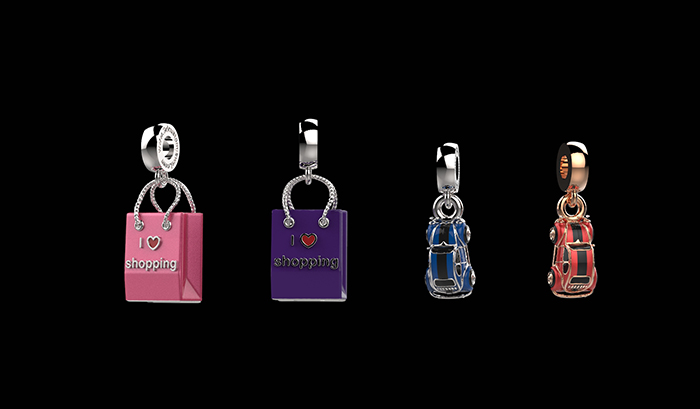The jewelry design of small charms or spacers is a world in itself.
There are unlimited possibilities, but before you even begin to model a small charm (that in real life will have between 10 to 20 mm) you have to consider what kind of manufacturing technology and jewelry specialists will collaborate in its realization.
Even though current printers achieve increasingly smaller and more detailed prototypes, it is still very important to take into account the limitations of the printer and the characteristics of the miniature jewel to achieve a really good appearance and make a jewel that will last.
Imagine for example a charm consisting of two parts with enamel; part of its manufacture could require welding and be therefore subject to the constraints of the available welding technology: does the client have a laser, argon or other type of welder? Furthermore: do they only use traditional methods of welding? If the piece requires welding, and is welded under fire, then depending on the type of glaze, it could hardly be joined/welded after glazing, and the same apply with stones or materials that cannot withstand heat.
That is just an example of constraints that affect the design. Let’s look at a few more examples of how the design must take into consideration the whole process and end result.
Final weight, metal used and how this affect thickness
If the client wants the weight to be as light as possible so that the cost are reasonable then different metals allow for different minimal thickness.
Gold allows thinner pieces than silver or bronze. So a 3d model designed for a final gold piece, would not be sufficiently resistant for the daily use using silver or bronze, and might end up with a bent or even broken piece.
Sometimes, if the final metal is not known, we need to find a middle point, so that the same model can be used for manufacturing jewels with different metals.
Enamels
There are enamels that can be applied in cold, others accept slight temperatures and others that need a special oven at high temperatures.
Stones
Likewise, the choice of stones also play a fundamental role. Mind that it is not even enough to just specify “zircons”: within the world of zircon, some resist the casting and others simply burn, so even when we talk about zircons the question is “what type”? Normal or heat resistant?
Type of stone setting
The type of setting also requires attention: there are companies that use the wax setting technique and others still prefer the manual setting, and the design must be prepared for each specific case.
It is not necessary to prepare a pre-setting in the 3d model when it is going to be done by a professional, and that simplifies and lowers the cost of the modelling.
At 3d custom jewel we are used to all kinds of challenges, and there is always a solution for each technical challenge, that is why we usually have a very fluid contact with the customer in order to obtain the information needed. In this way, it is possible to provide a 3d modelling service customized to the technologies and methods available to the customer.
We are always thinking about how to offer the best and most appropriate design service for your needs, hoping that your experience when you order your designs is as simple, pleasant and professional as possible.
We can affirm without fear of making a mistake that we are facing a revolution in the jewelry industry and that we will have to evolve along with it, always reinventing ourselves, in order to take advantage of new manufacturing technologies where all the details are of extreme importance if we want to that the result of the 3d jewel made is OPTIMAL and in this way be able to keep up with the great changes that are already taking place in the market, ever bigger, more productive and different than ever.


